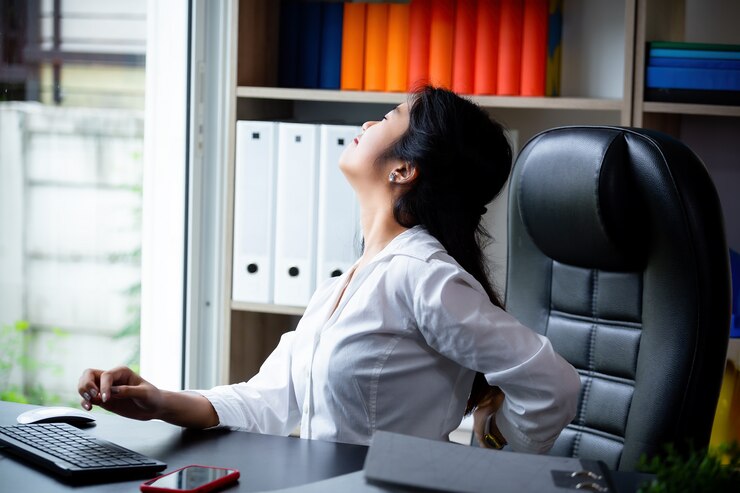
Best 2 Common Causes of Back Pain Identifying Common 2024
admin
- 0
- 18
Back pain can significantly impact daily activities and overall quality of life. Whether you’re sitting for long periods at a desk, engaging in strenuous physical activity, or experiencing the effects of aging, understanding the root causes of back pain is crucial for prevention and management.
By addressing these common issues, individuals can take proactive steps to alleviate discomfort and maintain a healthy back. We will explore the impact of poor posture and muscle strain on back pain and discuss strategies for minimizing their effects on the body.
Table of Contents
ToggleMuscle Strain Common Causes of Back Pain
Muscle strain is a prevalent cause of back pain, often resulting from overexertion during physical activity or poor posture. This condition can lead to discomfort and reduced mobility, impacting daily activities. Strengthening core muscles and practicing proper lifting techniques can help prevent these strains.
Start of Subsection
Definition And Explanation Common Causes of Back Pain
A muscle strain, also known as a pulled muscle, occurs when the muscle is overstretched or torn, causing damage to the muscle fibers. This type of injury is common, especially in the lower back, and can result from lifting heavy objects, sudden movements, poor posture, or overuse of the muscles.
End of Subsection
Start of Subsection
Symptoms
- Pain and stiffness: Often localized to the affected muscle or area of the back.
- Swelling and inflammation: Around the injured area.
- Reduced range of motion: Difficulty in moving the back or performing certain activities.
- Muscle spasms: Involuntary muscle contractions causing further discomfort.
End of Subsection
Start of Subsection
Treatment And Prevention
For muscle strain, initial treatment includes rest, ice, compression, and elevation (RICE) to reduce swelling and alleviate pain. Nonsteroidal anti-inflammatory drugs (NSAIDs) may also be used to manage pain and inflammation. Physical therapy and gentle stretching exercises can help in the recovery process.
Preventing muscle strains involves maintaining good posture, using proper body mechanics when lifting heavy objects, incorporating regular exercise to strengthen the back muscles, and avoiding overexertion.
End of Subsection
Poor Posture Common Causes of Back Pain
Having poor posture is a common cause of back pain that affects many people. It can result from everyday habits and activities, and if not addressed, it can lead to chronic discomfort and pain. Understanding the impact of poor posture and the activities that contribute to it is essential in preventing and managing back pain.
Impact Of Poor Posture
Poor posture can lead to a range of physical issues, particularly back pain. When the spine is not properly aligned, it can strain the muscles and cause discomfort. Over time, this can lead to structural changes in the spine, contributing to chronic pain and decreased flexibility. Additionally, poor posture can affect breathing and digestion, impacting overall health and well-being.
Common Activities Leading To Poor Posture Common Causes of Back Pain
Several common activities contribute to poor posture, including prolonged sitting, slouching, and improper lifting techniques. Working at a desk for extended periods without proper ergonomics can also lead to poor posture. Additionally, using electronic devices with poor posture habits, such as hunching over a smartphone or laptop, can put strain on the spine and lead to back pain.
Correcting Poor Posture
To correct poor posture, it is important to be mindful of body positioning throughout the day. Engaging in exercises that strengthen the core and back muscles can help improve posture. Practicing good ergonomics at workstations and being conscious of body alignment while sitting, standing, and walking can also help alleviate back pain caused by poor posture.
Herniated Disc
When it comes to back pain, one common cause is a herniated disc. Understanding what a herniated disc is and the symptoms and treatment options is crucial for anyone experiencing back pain.
Explanation Of Herniated Disc Common Causes of Back Pain
A herniated disc, also known as a slipped or ruptured disc, occurs when the soft, gel-like center of a spinal disc pushes through a crack in the tougher exterior casing. This can result in irritation of nearby nerves, leading to pain, numbness, or weakness in an arm or leg.
Symptoms
- Back Pain: Pain in the affected area, especially when moving or while sitting.
- Nerve Pain: Shooting pain, tingling, numbness or weakness in the affected area, often radiating down the arm or leg.
- Muscle Weakness: Weakness in certain muscles, affecting mobility or causing clumsiness.
- Bowel or Bladder Dysfunction: In severe cases, a person may experience difficulty controlling bowel or bladder movements.
Treatment Options
- Rest: A period of rest to allow the disc to heal and inflammation to subside.
- Physical Therapy: Exercise and stretching to help relieve pressure on the nerves and strengthen the back muscles.
- Medication: Pain relievers and anti-inflammatory medications to help manage pain and reduce inflammation.
- Epidural Injections: Injections of corticosteroids into the spine to reduce inflammation around the affected nerve.
- Surgery: In severe cases, surgery may be necessary to remove the herniated portion of the disc and relieve pressure on the nerves.

Spinal Stenosis
Spinal stenosis is a common cause of back pain, often caused by the natural aging process or degenerative changes in the spine. It can lead to narrowing of the spinal canal, putting pressure on the nerves and causing discomfort. Another frequent cause of back pain is a spinal herniated disc, which occurs when the inner core of the disc leaks out through the outer core, irritating nearby nerves and resulting in pain.
Introduction:
Spinal stenosis is a common cause of back pain that occurs when the spaces within your spine narrow, putting pressure on the nerves that travel through the spine. This condition can result in significant discomfort and restricted mobility for those affected. Understanding the overview, symptoms and diagnosis, as well as treatment and management of spinal stenosis is crucial in tackling this debilitating back pain issue.
Overview Of Spinal Stenosis
Spinal stenosis is a condition characterized by the narrowing of the spinal canal or intervertebral foramina, resulting in compression of the spinal cord and nerve roots. This compression can lead to a variety of symptoms, including pain, numbness, and weakness in the back and legs. There are two main types of spinal stenosis: lumbar stenosis, which occurs in the lower back, and cervical stenosis, which occurs in the neck. Lumbar stenosis is more common and often associated with aging and degenerative changes in the spine, while cervical stenosis can result from conditions such as arthritis or injury.
Symptoms And Diagnosis
The symptoms of spinal stenosis can vary depending on the location and severity of the condition. Common symptoms include back pain, leg pain, numbness or tingling in the extremities, and difficulty walking or maintaining balance. Diagnosis typically involves a thorough physical examination, including testing for reflexes, strength, and sensation in the affected areas. Imaging studies such as X-rays, MRI, or CT scans may also be used to visualize the spinal structures and confirm the diagnosis.
Treatment And Management
Treatment for spinal stenosis aims to alleviate symptoms, improve function, and prevent further progression of the condition. Conservative treatment options may include physical therapy, medications to manage pain and inflammation, and activity modification. In some cases, corticosteroid injections or nerve blocks may be recommended to provide temporary relief. For severe or persistent symptoms, surgical intervention such as decompression or spinal fusion may be necessary to create more space within the spinal canal and relieve pressure on the nerves.
By understanding the causes, symptoms, and treatment options for spinal stenosis, individuals can take proactive steps to manage their back pain and improve their quality of life.
Frequently Asked Questions On What Are 2 Common Causes Of Back Pain?
What Are The Common Causes Of Back Pain?
Back pain often results from muscle strain or injury due to poor posture or repetitive motion.
How Can Poor Posture Contribute To Back Pain?
Sitting or standing with poor posture places extra stress on the spine, leading to discomfort and pain.
Is Lack Of Exercise A Common Cause Of Back Pain?
Yes, a sedentary lifestyle weakens the muscles and can lead to back pain and discomfort over time.
Can Lifting Heavy Objects Cause Back Pain?
Lifting heavy objects improperly or without proper technique can strain the back muscles, leading to pain and discomfort.
Conclusion
In understanding the root causes of back pain, it is clear that poor posture and muscle strain are two common culprits. By making simple lifestyle adjustments and seeking appropriate medical attention, individuals can effectively manage and alleviate their back pain.
Building awareness and taking proactive measures can lead to a healthier and pain-free lifestyle.



